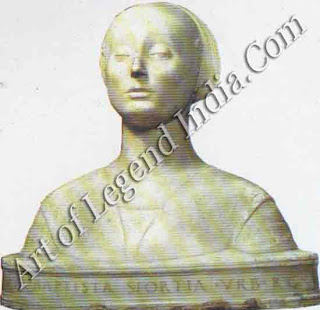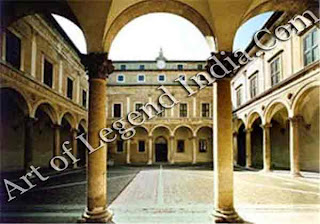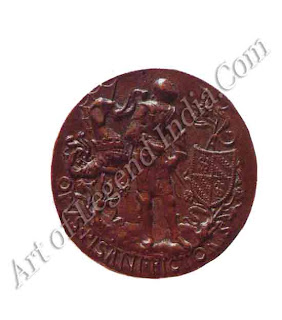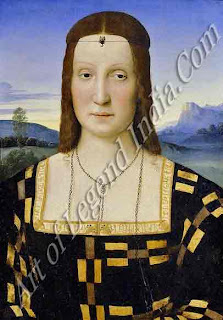 The Court of Urbino
The Court of Urbino
Standing
out as a fine example of Renaissance civilization, the magnificent court of
Urbino was a cultural magnet, attracting artists, craftsmen, intellectuals and
those in search of knowledge.
Federigo
da Montefeltro (1422-82) was the last of the great condottieri, that breed of
professional soldiers who sold their skills to warring states. By all accounts
he was an unusually gifted man who became ruler of Urbino by popular demand
after the murder of his half brother, Oddantonio. His reputation as a
trustworthy general made him increasingly sought after, and enabled him to
charge high fees for his services. And the income from these military campaigns
provided the funds for Federigo's greatest achievement, the Ducal Palace of
Urbino, in which he assembled a court that became a scintillating example of
Renaissance civilization.

As the
Duke, Federigo himself set the standard for court life. He had been given the
all round education of character, mind and body offered by the famed Vittorino
da Feltre, and attempted in his own life to combine the virtuous man of action
with the intellectual. He had the typical Renaissance characteristics the need
for display, self-expression and prestige and he channelled these aspects of
his personality into the public life of the court; personally, he maintained a
sober and ordered existence.
Federigo
was a deeply religious man. But his was not a narrow belief rather it was a
broad understanding, in keeping with the inquiring spirit of the age. And the
all-embracing nature of his mind is indicated by the plans he made for various
temples to be built within the court. One was to be dedicated to the Christian
divinity, another to poetry and humanity, a third to nature triumphant. This
seeming paganism, far from threatening his Christianity, reinforced it.
SEEKING KNOWLEDGE
 Constantly
in search of knowledge, Federigo encouraged speculation. He studied philosophy
and practiced Latin and Greek. One biographer praised him for his skill in
geometry and arithmetic, claiming that the Duke made a point of acquiring some
new piece of knowledge every day. Meanwhile his artistic patronage also
represented power, and reflected his military success. In 1465 Federigo was
appointed Captain of the Papal armies, and in some of the disputes between
rival city states it was he who held the balance of power. Consequently, it was
as much from self-protection as from profit that he took employment against the
Malatesta family of Rimini and then later allied with them against Papal greed.
Constantly
in search of knowledge, Federigo encouraged speculation. He studied philosophy
and practiced Latin and Greek. One biographer praised him for his skill in
geometry and arithmetic, claiming that the Duke made a point of acquiring some
new piece of knowledge every day. Meanwhile his artistic patronage also
represented power, and reflected his military success. In 1465 Federigo was
appointed Captain of the Papal armies, and in some of the disputes between
rival city states it was he who held the balance of power. Consequently, it was
as much from self-protection as from profit that he took employment against the
Malatesta family of Rimini and then later allied with them against Papal greed.

Castiglione
in his famous Book of the Courtier described Federigo as 'the light of Italy'.
Certainly for later generations this book put Urbino on the map, as the ideal
city state whose inhabitants pursued the most refined code of manners
available. Undoubtedly, the women of the court were a greatly civilizing
presence. Two in particular, Federigo's wife, Battista Sforza, and his
daughter-in-law, Elisabetta Gonzaga, enjoyed a reputation for possessing
formidable intelligence and personality. Customs were changing: greater respect
was paid to the opinions of women, especially when the Duchess proved so
capable of governing in the Duke's absence on campaign.
Details
of everyday life at the court of Urbino are few. Federigo's reign was described
in several chronicles, but the writers pay most attention to his military
exploits. Some interesting figures were recorded, however, which gave an
indication of the royal scale of life in the palace. There were some 500 people
at the court and this figure included 200 servants, five 'readers aloud' at
meals, and a man whose job was to look after the pet giraffe.
THE RENAISSANCE GENTLEMAN
 The
Book of the Courtier portrays the ideal lifestyle for the ideal courtier, with
the right mixture of physical pursuits, such as hunting or tennis, and the
mental delights of brilliant discussions and intellectual games. In some ways
it is a political book, justifying the new profession of courtier as the
natural Renaissance successor to the medieval knight. Here is the notion of the
universal man warrior and scholar, Christian believer and classical hero, the
product of an integrated and disciplined education. But Castiglione is
deliberately idealizing: the real Urbino, which remained somewhat provincial
despite the Montefeltro influence, and the inevitable crudeness of early
16th-century court life are fictionalized into perfection. Yet of all the city
states Urbino came closest to the ideal. In comparison to a contemporary ruler
like Sigismondo Malatesta, whom Pope Pius II denounced for practising incest
and barbaric cruelty, Duke Federigo was conspicuously civilized. The court
reflected the man, and its fame spread.
The
Book of the Courtier portrays the ideal lifestyle for the ideal courtier, with
the right mixture of physical pursuits, such as hunting or tennis, and the
mental delights of brilliant discussions and intellectual games. In some ways
it is a political book, justifying the new profession of courtier as the
natural Renaissance successor to the medieval knight. Here is the notion of the
universal man warrior and scholar, Christian believer and classical hero, the
product of an integrated and disciplined education. But Castiglione is
deliberately idealizing: the real Urbino, which remained somewhat provincial
despite the Montefeltro influence, and the inevitable crudeness of early
16th-century court life are fictionalized into perfection. Yet of all the city
states Urbino came closest to the ideal. In comparison to a contemporary ruler
like Sigismondo Malatesta, whom Pope Pius II denounced for practising incest
and barbaric cruelty, Duke Federigo was conspicuously civilized. The court
reflected the man, and its fame spread.
 Federigo
wanted an architectural monument to give expression to both his power and
taste. Believing as he did that architecture was the greatest of the arts, and
of primary importance in moulding social patterns and ethics, great care,
therefore, was taken in the design of the Palace. And its success can be
measured by the way the court inspired not only established intellects but also
the young. Urbino became an educational centre to which wealthy Italian and
even foreign families sent their children. At least two important figures of
the later Renaissance were stimulated by these cultured surroundings: both
Raphael and Bramante were brought up in and around Urbino. Tradition has it
that Bramante studied perspective under Piero della Francesca; certainly
Bramante's own architecture was influenced by the design of the Ducal Palace.
And Raphael's father was Duke Federigo's chronicler and court poet: the court
connections were well-established.
Federigo
wanted an architectural monument to give expression to both his power and
taste. Believing as he did that architecture was the greatest of the arts, and
of primary importance in moulding social patterns and ethics, great care,
therefore, was taken in the design of the Palace. And its success can be
measured by the way the court inspired not only established intellects but also
the young. Urbino became an educational centre to which wealthy Italian and
even foreign families sent their children. At least two important figures of
the later Renaissance were stimulated by these cultured surroundings: both
Raphael and Bramante were brought up in and around Urbino. Tradition has it
that Bramante studied perspective under Piero della Francesca; certainly
Bramante's own architecture was influenced by the design of the Ducal Palace.
And Raphael's father was Duke Federigo's chronicler and court poet: the court
connections were well-established.
Federigo
and even Piero probably had a hand in the design of the Ducal Palace, but the
two principal architects were the little-known Luciano Laurana, and his
successor the Sienese, Francesco di Giorgio. Numbers of anonymous craftsmen
came from all over Italy, while individual masters like Ambrogio da Milano and
Domenico Rosselli of Pistoia were engaged for the more important ornamental
carvings. This creative ferment also attracted many painters, among who was
Melozzo da Forli and the Spanish court painter Pedro Berruguete, who worked on
palace decorations.
HOUSE FOR INTELLECTUALS
Flemish
influence was relatively strong at Urbino and was reflected in Federigo's
musical tastes and in the number of Flemish intellectuals and textile artisans
who visited the court. Prominent Italians were also attracted: conversation,
for example, between Piero and Alberti or the painter Mantegna, presided over
by Federigo himself, promised a rare level of intellectual stimulation.
Federigo built up an unsurpassed library, with the help of the Florentine
Vespasiano da Bisticci and a number of writers (including Piero, in his book on
perspective in painting) dedicated works to the Duke of Urbino. Indeed the
court was the ideal intellectual context for an artist like Piero, whose
mathematical investigations to some extent a theoretical search for universal principles,
and explanation of life were very much the concern of that universal man, the
Renaissance courtier.
Writer
– Marshall Cavendish
 The Court of Urbino
The Court of Urbino  Constantly
in search of knowledge, Federigo encouraged speculation. He studied philosophy
and practiced Latin and Greek. One biographer praised him for his skill in
geometry and arithmetic, claiming that the Duke made a point of acquiring some
new piece of knowledge every day. Meanwhile his artistic patronage also
represented power, and reflected his military success. In 1465 Federigo was
appointed Captain of the Papal armies, and in some of the disputes between
rival city states it was he who held the balance of power. Consequently, it was
as much from self-protection as from profit that he took employment against the
Malatesta family of Rimini and then later allied with them against Papal greed.
Constantly
in search of knowledge, Federigo encouraged speculation. He studied philosophy
and practiced Latin and Greek. One biographer praised him for his skill in
geometry and arithmetic, claiming that the Duke made a point of acquiring some
new piece of knowledge every day. Meanwhile his artistic patronage also
represented power, and reflected his military success. In 1465 Federigo was
appointed Captain of the Papal armies, and in some of the disputes between
rival city states it was he who held the balance of power. Consequently, it was
as much from self-protection as from profit that he took employment against the
Malatesta family of Rimini and then later allied with them against Papal greed.
 The
Book of the Courtier portrays the ideal lifestyle for the ideal courtier, with
the right mixture of physical pursuits, such as hunting or tennis, and the
mental delights of brilliant discussions and intellectual games. In some ways
it is a political book, justifying the new profession of courtier as the
natural Renaissance successor to the medieval knight. Here is the notion of the
universal man warrior and scholar, Christian believer and classical hero, the
product of an integrated and disciplined education. But Castiglione is
deliberately idealizing: the real Urbino, which remained somewhat provincial
despite the Montefeltro influence, and the inevitable crudeness of early
16th-century court life are fictionalized into perfection. Yet of all the city
states Urbino came closest to the ideal. In comparison to a contemporary ruler
like Sigismondo Malatesta, whom Pope Pius II denounced for practising incest
and barbaric cruelty, Duke Federigo was conspicuously civilized. The court
reflected the man, and its fame spread.
The
Book of the Courtier portrays the ideal lifestyle for the ideal courtier, with
the right mixture of physical pursuits, such as hunting or tennis, and the
mental delights of brilliant discussions and intellectual games. In some ways
it is a political book, justifying the new profession of courtier as the
natural Renaissance successor to the medieval knight. Here is the notion of the
universal man warrior and scholar, Christian believer and classical hero, the
product of an integrated and disciplined education. But Castiglione is
deliberately idealizing: the real Urbino, which remained somewhat provincial
despite the Montefeltro influence, and the inevitable crudeness of early
16th-century court life are fictionalized into perfection. Yet of all the city
states Urbino came closest to the ideal. In comparison to a contemporary ruler
like Sigismondo Malatesta, whom Pope Pius II denounced for practising incest
and barbaric cruelty, Duke Federigo was conspicuously civilized. The court
reflected the man, and its fame spread.  Federigo
wanted an architectural monument to give expression to both his power and
taste. Believing as he did that architecture was the greatest of the arts, and
of primary importance in moulding social patterns and ethics, great care,
therefore, was taken in the design of the Palace. And its success can be
measured by the way the court inspired not only established intellects but also
the young. Urbino became an educational centre to which wealthy Italian and
even foreign families sent their children. At least two important figures of
the later Renaissance were stimulated by these cultured surroundings: both
Raphael and Bramante were brought up in and around Urbino. Tradition has it
that Bramante studied perspective under Piero della Francesca; certainly
Bramante's own architecture was influenced by the design of the Ducal Palace.
And Raphael's father was Duke Federigo's chronicler and court poet: the court
connections were well-established.
Federigo
wanted an architectural monument to give expression to both his power and
taste. Believing as he did that architecture was the greatest of the arts, and
of primary importance in moulding social patterns and ethics, great care,
therefore, was taken in the design of the Palace. And its success can be
measured by the way the court inspired not only established intellects but also
the young. Urbino became an educational centre to which wealthy Italian and
even foreign families sent their children. At least two important figures of
the later Renaissance were stimulated by these cultured surroundings: both
Raphael and Bramante were brought up in and around Urbino. Tradition has it
that Bramante studied perspective under Piero della Francesca; certainly
Bramante's own architecture was influenced by the design of the Ducal Palace.
And Raphael's father was Duke Federigo's chronicler and court poet: the court
connections were well-established. 












0 Response to "Italian Great Artist Piero Della Francesca - The Court of Urbino "
Post a Comment